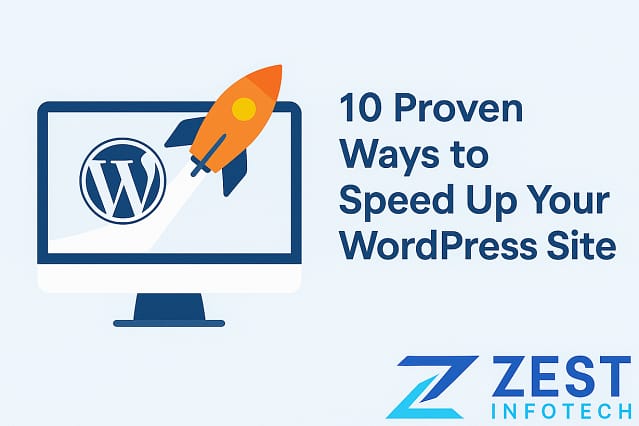If you own a WordPress website, speed optimization should be at the top of your priority list. A fast-loading website improves user experience, boosts SEO rankings, and directly increases conversions. In this blog, we’ll break down 10 proven ways to supercharge your WordPress site speed and keep your visitors (and Google) happy.
✅ Focus Keyword: WordPress speed optimization
🎯 CTA: Want to see how your site performs? Get a FREE Speed Audit Now
Table of Contents
ToggleWhy WordPress Speed Optimization Matters
Before diving into the strategies, let’s understand why speed matters:
- Bounce Rate: A slow site can increase your bounce rate by 32% if the load time exceeds 3 seconds.
- SEO Ranking: Google uses site speed as a ranking factor.
- Conversions: Every 1-second delay can reduce conversions by 7%.
At Zest Infotech, we’ve helped hundreds of businesses achieve lightning-fast WordPress websites with real results.
1. ✅ Choose a Fast and Lightweight Theme
Your theme sets the foundation of your site. Bloated or poorly coded themes slow everything down.
Recommendation: Use lightweight themes like:
- Astra
- GeneratePress
- Neve
These are optimized for speed and built with performance in mind.
2. ✅ Use a Reliable Hosting Provider
Your web host plays a major role in website performance. Shared hosting might be budget-friendly, but it often compromises speed.
Go for:
- Cloud hosting (e.g., Cloudways, Kinsta)
- Managed WordPress hosting
- SSD-based servers
At Zest Infotech, we recommend scalable cloud hosting based on your business size.
3. ✅ Install a Caching Plugin
Caching generates static versions of your pages, so they load faster without repeated processing.
Best caching plugins:
- WP Rocket (Premium and top-rated)
- LiteSpeed Cache (Best for LiteSpeed servers)
- W3 Total Cache
WP Rocket is our go-to for most client websites because of its simplicity and results.
4. ✅ Optimize Images for Web
Images often account for over 50% of a site’s load time. Use compressed and properly sized images.
Tips:
- Convert images to WebP format
- Use tools like TinyPNG, ShortPixel, or Imagify
- Avoid uploading large images and resizing them using HTML/CSS
Zest Infotech also offers automated image optimization as part of our speed packages.
5. ✅ Minify CSS, JS, and HTML
Minification removes unnecessary characters (spaces, comments) from code to reduce size.
Tools:
- Autoptimize
- WP Rocket
- Asset CleanUp
This alone can cut down your page load size by 20-30%.
6. ✅ Use a Content Delivery Network (CDN)
A CDN serves your website content from servers closer to your visitor’s location, reducing latency.
Top CDNs:
- Cloudflare (Free and effective)
- BunnyCDN
- KeyCDN
With Cloudflare integrated, one of our clients saw a 42% improvement in global page load times.
7. ✅ Clean Up Your WordPress Database
Over time, your WordPress database collects unnecessary data like revisions, transients, and spam comments.
Use:
- WP-Optimize
- Advanced Database Cleaner
Regular cleanup can significantly reduce database load time, especially on high-traffic websites.
8. ✅ Disable Unused Plugins and Themes
Each active plugin adds to your site’s load. Too many plugins = higher risk of slowdowns and conflicts.
Do this:
- Deactivate and delete unused plugins/themes
- Use multi-functional plugins over multiple single-purpose ones
- Regularly audit your plugin list
We recommend limiting to 20 or fewer active plugins unless absolutely needed.
9. ✅ Implement Lazy Loading
Lazy loading defers the loading of images/videos below the fold until the user scrolls.
Why it works:
- Reduces initial page size
- Decreases time to first paint (TTFP)
Plugins:
- Native WordPress lazy loading (enabled by default since WP 5.5)
- a3 Lazy Load
- WP Rocket’s built-in lazy load
Lazy loading is a must for media-heavy websites.
10. ✅ Enable GZIP Compression
GZIP compresses your files before they’re sent to the browser—reducing file size dramatically.
Enable via:
- .htaccess (Apache servers)
- Hosting settings
- WP Rocket or other caching plugins
GZIP can reduce file sizes by up to 70%, leading to much faster page delivery.
Bonus: Monitor Performance with Tools
Regularly test your site using:
- Google PageSpeed Insights
- GTmetrix
- Pingdom Tools
These tools provide actionable recommendations and benchmarks to track progress.
At Zest Infotech, we not only optimize but also monitor your site regularly to maintain peak performance.
Common Mistakes to Avoid
Even after optimizing, these common issues can creep back:
- Not updating WordPress and plugins
- Using too many external scripts (e.g., fonts, ads)
- Not optimizing mobile speed
- Ignoring server response time
By avoiding these mistakes, you ensure your optimization efforts last.
What Results Can You Expect?
After implementing the above steps, our clients typically experience:
- Up to 60% faster load times
- Reduced bounce rates
- Better SEO rankings
- Improved conversions
🧪 Want to find out where your site stands right now?
📊 Get a FREE WordPress Speed Audit (Limited Offer)
At Zest Infotech, we offer a free, no-obligation WordPress speed audit where we:
- Analyze your current speed and performance
- Highlight the top bottlenecks
- Share a tailored improvement plan
👉 Schedule Your FREE Speed Audit Now
You’ll receive a report within 24 hours—no tech jargon, just clear actions.
Conclusion
Speed = Trust. Speed = Revenue. Speed = Success.
With these 10 proven techniques, you can turn your sluggish WordPress site into a blazing-fast experience. Don’t let a slow website cost you visitors or revenue.
Whether you’re managing a blog, portfolio, or WooCommerce store—WordPress speed optimization is non-negotiable.
And if you’d rather let the experts handle it—we’re here to help.


